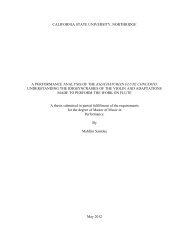2644 - CSUN ScholarWorks - California State University, Northridge
2644 - CSUN ScholarWorks - California State University, Northridge
2644 - CSUN ScholarWorks - California State University, Northridge
Create successful ePaper yourself
Turn your PDF publications into a flip-book with our unique Google optimized e-Paper software.
Journal of Student Research Abstracts · 5<br />
Tomasek. The "lamp" is constructed from colorful yeast beads encapsulated in a glass/alginate mixture. When<br />
the beads are placed in an enclosed container or sugar and water, they will slowly rise to the surface of the partially<br />
filled container, pause momentarily, then slowly descend to the bottom. The motion of the beads repeats<br />
until all of the sugar is metabolized by the yeast. The slow, continuous movement of the colored beads is reminiscent<br />
of the 1960's lava lamps. Quantitative measurement of this metabolism is recorded by carbon dioxide<br />
bubble counters (fermenters) placed on top of the containers, usually two-liter plastic bottles. Students were<br />
able to implement the King-Tomasek protocol, construct the "lamp", and measure optimal sugar (sucrose) concentrations.<br />
Sugar concentrations in different containers were "tagged" by different colored yeast beads with<br />
uncolored beads given to the control of no sugar or 0% concentration. Students evaluated carbon dioxide productivity<br />
by (a) maximum bubble count, and (b) longevity of output. Bubble counts were recorded on a daily<br />
basis for a number of days. A 20% (by weight) sugar concentration was found to be optimal by the students<br />
according to productivity criteria. This optimum can serve as a control for further student experimentation on<br />
yeast-sugar (or sweetener) metabolism.<br />
2642<br />
UNDER WHAT CONDITIONS DOES YEAST RESPIRE THE MOST RAPIDLY?<br />
Stephen Herr, and Shirley Deedon (teacher). Valley Presbyterian School, 9200 N. Haksell Ave., North Hills,<br />
CA 91343.<br />
Experiments were developed to determine the optimal conditions for yeast respiration as measured by the<br />
production of carbon dioxide that was collected by water displacement. Flasks containing 2.0 grams of baker's<br />
yeast, Saccharomyces cereviseae, and a constant amount of sucrose, were placed in water baths at different<br />
temperatures from 1 oo to 70° C. It was determined that yeast respired best at approximately 45° C. When the<br />
experiment was repeated at 45° C using sugar concentrations from 0 to 30% (by weight), it was determined<br />
that yeast respired most rapidly in a 24% sucrose solution. Keeping the temperature at 45° C, yeast was put in<br />
24% sugar solutions ranging from pH 1 to 12 and it was found that yeast respired most rapidly at pH 7. It was<br />
determined that the addition of salt reduced the respiration rate when temperature, sugar concentration and pH<br />
were kept constant at optimal values. When Nutra-sweet® was substituted for sucrose the respiration rate<br />
decreased indicating that yeast respires more rapidly in natural sugar. It was concluded that baker's yeast<br />
respires most rapidly at 45° C, in 24% sucrose solution, at a pH of 7, with no additional salt.<br />
2643<br />
CAN COLLEMBOLAS BE LOCATED ON HARTE MIDDLE SCHOOL CAMPUS?<br />
Cindy Martinez, Jose Lopez and Dr. Charles B. Lawrence (teacher). Bret Harte Preparatory Intermediate<br />
School, 9301 Hoover Street, Los Angeles, CA 90044.<br />
Experiments were designed to test the hypothesis that collembolas could be found on Harte M.S. Campus.<br />
Six (6) separate sites were used to collect leaf litter and soil samples. Each site was indicated on the data sheet<br />
and school site maps produced by the class and each site was tested for collembola. The Tullgren funnel and<br />
floating methods were used along with a loop to collect collembola from the collecting jars and place the located<br />
collembola into a culture jar, which was established using activated charcoal and plaster of paris. Two<br />
species of collembola were found at three of the six sites. Entomobryidae were located on two sites both in<br />
leaf litter, neonuridae were located on one site, also in leaf litter. A completed data sheet and site map of all<br />
findings is being kept. Culture jars consisting of collembolas located are being kept, fed household yeast and<br />
watered with a pipette on a daily basis, as culturing is continuous. It is concluded that collembolas can be located<br />
on Harte M.S. Campus.













